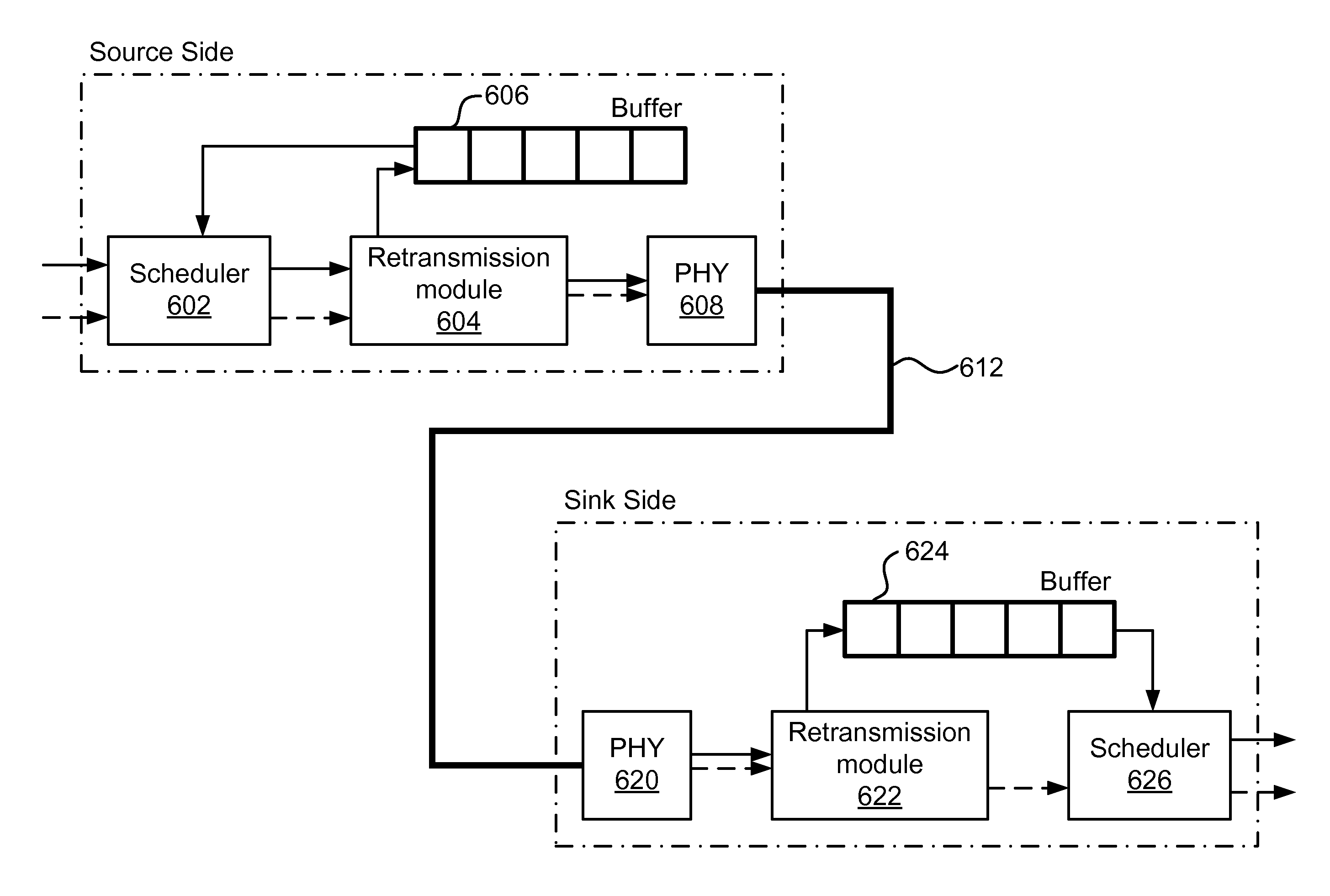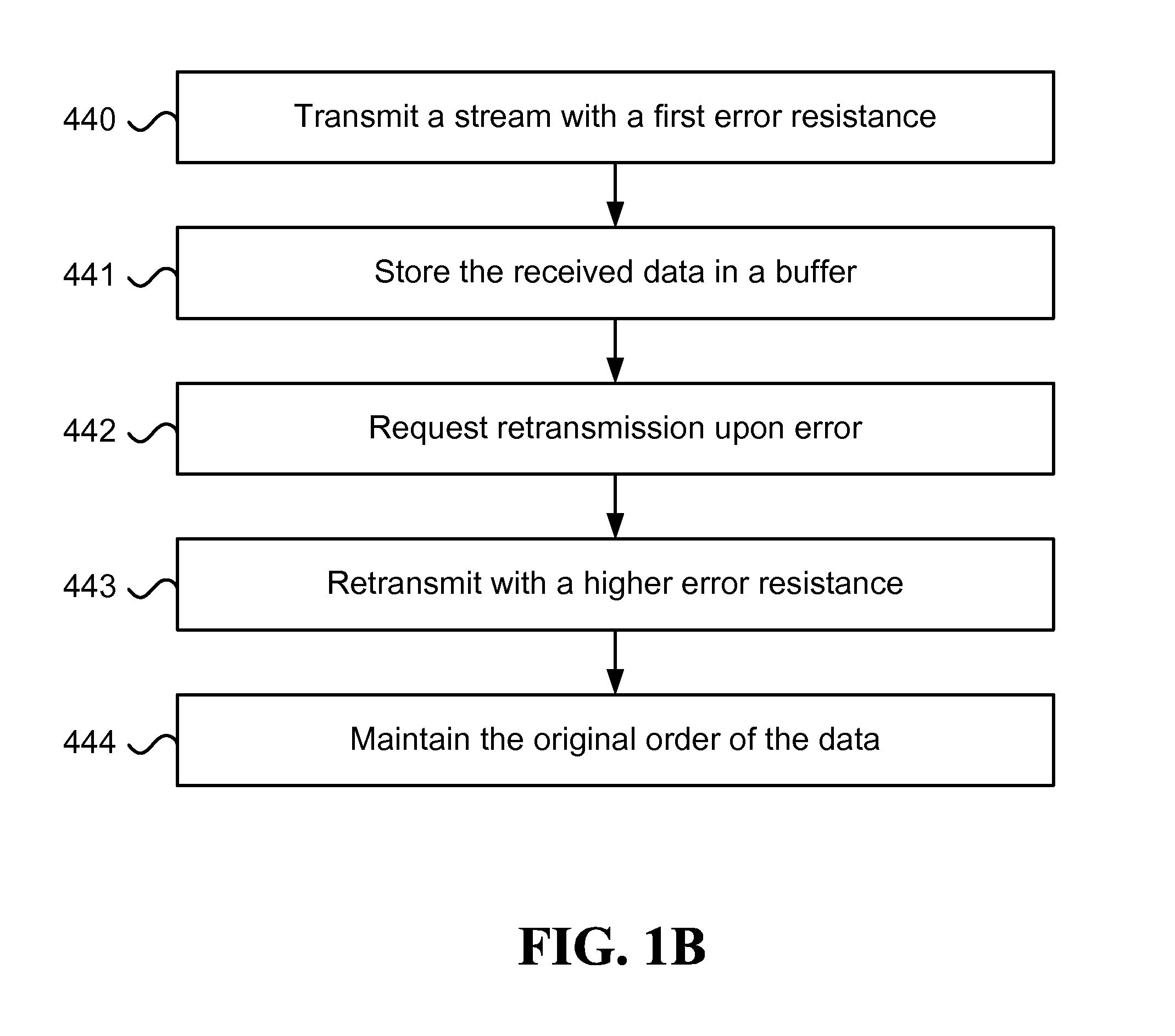[0005]In one embodiment, a communication link comprising: a first
transceiver configured to transmit a first set of packets at a predetermined rate with a first error resistance level, store the transmitted data in a buffer, receive a
retransmission request, and retransmit the relevant data using one or more packets encoded with a second error resistance level that is higher than the first error resistance level; and a second transceiver configured to receive the first set of packets, detect an erroneous packet, request retransmission of the erroneous packet, and forward the data received in the packets according to its original order approximately after a fixed
delay. Optionally, most of the packets comprise packet headers featuring a higher error resistance level than the packet payloads. Optionally, the average
throughput and maximum burst of the retransmissions are controlled. Optionally, the first transceiver controls the retransmissions. Optionally, the second transceiver controls the retransmissions. Optionally, the maximum amount of retransmitted packets is determined so as not to interfere with the proper transmission of the first set of packets. Optionally, the maximal
throughput of the transmissions of the first set of packets and the retransmitted packets approaches the maximum capacity of the communication link. Optionally, the retransmitted packets are transmitted with a priority higher than the priority of the first set of packets, whereby the higher priority reduces the latency of the communication link. Optionally, the communication is over a wired medium. Optionally, the communication is over a
wireless medium. Optionally, the communication is over an
optical medium. Optionally, the communication link is coupled to an end device that does not support retransmission. Optionally, the received data is forwarded after an approximately fixed delay with extremely low variance. Optionally, the fixed delay is in the order of the round trip delay. Optionally, the communication link carries a first and a second
stream; at least some of the packets of the first
stream are to be protected by retransmissions, and the packets of the second
stream are not to be protected by retransmissions. Optionally, a network comprising at least three of the above described communication links ensures an approximately fixed latency with extremely low latency variance. Optionally, the network operates well with end devices that do not support retransmission.
[0006]In one embodiment, a
receiver comprising: a packet buffer configured to store received packets; a
packet processing element coupled to the packet buffer and configured to detect erroneous packets and send a retransmission request upon detection of an erroneous packet, wherein the retransmitted packet features a higher error resistance than the initial packet; the packet buffer is further configured to store at least one additional packet before storing the retransmitted packet; and the
packet processing element is further configured to maintain the original order of the packets by inserting the retransmitted packet to its proper location. Optionally, most of the packets comprise packet headers featuring a higher error resistance than the packet payloads. Optionally, most of the packet headers are encoded using a lower modulation scheme than the modulation scheme used to
encode their corresponding packet payloads. Optionally, the erroneous packets include missing packets. Optionally, the missing packets are identified using a packet identification code that is assigned according to a predefined series of codes; whereby the
packet processing element identifies the missing packets by comparing the packet identification codes of the received packets with the expected packet identification codes of the series. Optionally, the
receiver is configured to operate at a
throughput close to its maximum possible throughput. Optionally, some of the received packets are to be protected by retransmission requests and some of the received packets are not to be protected by retransmission requests. Optionally, the packets comprise a field used to mark whether the packet is to be protected by retransmission, and in most of the packets the field features a higher error resistance than the
packet payload. Optionally, the
receiver receives packets belonging to a first and second streams; at least some of the packets of the first stream are to be protected by retransmissions, and the packets of the second stream are not to be protected by retransmissions. Optionally, a
system comprising the above described receiver is configured to transmit the packets to the receiver over a communication link; wherein most of the packets carry time-sensitive data, and the
system ensures approximately fixed latency with extremely low latency variance. Optionally, a network comprising receivers and transmitters as described above ensures approximately fixed latency with extremely low latency variance. Optionally, the network operates well with end devices that do not support retransmission.
[0008]In one embodiment, a method for operating a communication link close to its maximum capacity while maintaining the original order of transmitted data, comprising: transmitting at least one stream of data at a predetermined rate, the transmitted data featuring a first error resistance level; storing the received data in a buffer; requesting data retransmission upon detection of an error; retransmitting the data with a second error resistance level that is higher than the first error resistance level; and inserting the retransmitted data into the proper location in the buffer so as to maintain the original order of the data. Optionally, the method is operated over each hop of a network that maintains the original order of the data and features a short and approximately fixed latency with extremely low latency variance. Optionally, the data is transmitted using packets and most of the packets comprise packet headers featuring a higher error resistance than the packet payloads. Optionally, the method further comprising modulating most of the packet headers using a lower modulation than the modulation used to modulate the corresponding packet payloads. Optionally, the detected error includes a missing packet error, and further comprising identifying the missing packet using a packet identification code that is assigned according to a predefined series of codes. Optionally, the method further comprising transmitting another stream for which no retransmissions are requested. Optionally, the method further comprising marking which of the packets is to be protected by a retransmission and which is not. Optionally, the stream comprises time-sensitive data, and the method ensures approximately fixed latency with extremely low latency variance. Optionally, the method further comprising receiving the at least one stream of data at the predetermined rate with the first error resistance level from an end device that does not support retransmission.
 Login to View More
Login to View More  Login to View More
Login to View More 


